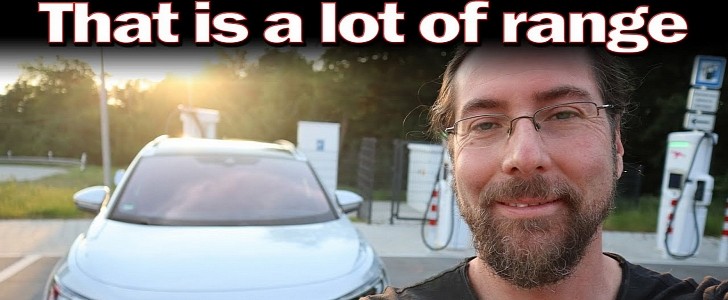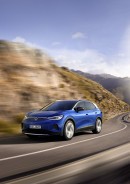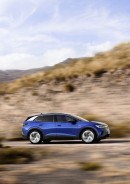Whenever anyone uses EPA range numbers to compare EVs, that becomes an issue. Since Car and Driver revealed that you could get different numbers depending on the measuring method you adopt, it became clear we need a more trustworthy standard.
A good example is a recent VW ID.4 range test made by the YouTube channel Battery Life. While EPA said this car could travel 260 mi (418 km), Christian Stadler achieved 328 mi (528 km) in his test.
The YouTuber did his test at a constant speed of 89.3 kph (55.4 mph), which can explain the more extended range, but he also left the air-conditioner turned on all the time. It was a hot day in Germany (32ºC, or 89.6ºF), and he was not willing to drive for more than five hours sweating buckets. That should have made the energy consumption get really high. Yet, Stadler managed to spend only 145 Wh/km.
The rear-wheel-drive ID.4 he tested has an 82 kWh battery pack with 77 kWh of usable capacity. The rest is kept as a buffer to preserve the battery pack life, especially if the owners need to fast charge it often.
The different methods to obtain the EPA range proved to backfire when Edmunds tested multiple electric cars under the same conditions. They did that because Tesla vehicles had failed to achieve their disclosed numbers. The American EV maker uses the procedure that presents higher range figures.
After submitting all cars to the same conditions, Edmunds considered that only one Tesla vehicle matched its range numbers with those presented by EPA. It was the Model 3 Long Range, even if it didn’t. While its EPA range is 353 mi, Edmunds achieved 345 mi and decided that it was too close to call it a defeat. All other electric cars tested surpassed their official EPA range figures.
A good example is a recent VW ID.4 range test made by the YouTube channel Battery Life. While EPA said this car could travel 260 mi (418 km), Christian Stadler achieved 328 mi (528 km) in his test.
The YouTuber did his test at a constant speed of 89.3 kph (55.4 mph), which can explain the more extended range, but he also left the air-conditioner turned on all the time. It was a hot day in Germany (32ºC, or 89.6ºF), and he was not willing to drive for more than five hours sweating buckets. That should have made the energy consumption get really high. Yet, Stadler managed to spend only 145 Wh/km.
The rear-wheel-drive ID.4 he tested has an 82 kWh battery pack with 77 kWh of usable capacity. The rest is kept as a buffer to preserve the battery pack life, especially if the owners need to fast charge it often.
The different methods to obtain the EPA range proved to backfire when Edmunds tested multiple electric cars under the same conditions. They did that because Tesla vehicles had failed to achieve their disclosed numbers. The American EV maker uses the procedure that presents higher range figures.
After submitting all cars to the same conditions, Edmunds considered that only one Tesla vehicle matched its range numbers with those presented by EPA. It was the Model 3 Long Range, even if it didn’t. While its EPA range is 353 mi, Edmunds achieved 345 mi and decided that it was too close to call it a defeat. All other electric cars tested surpassed their official EPA range figures.










































































